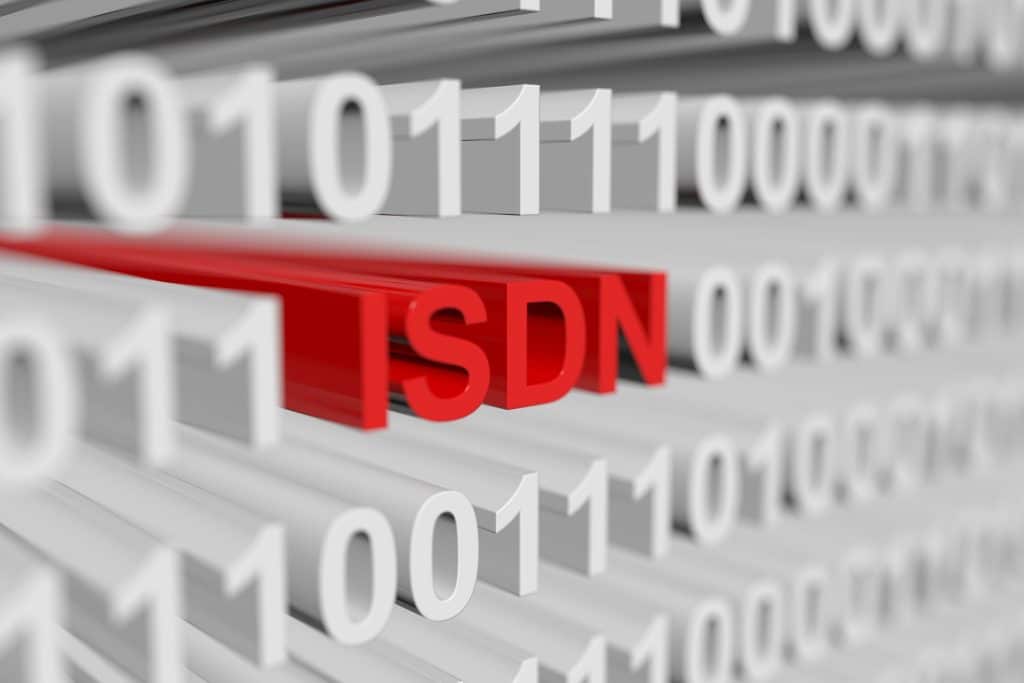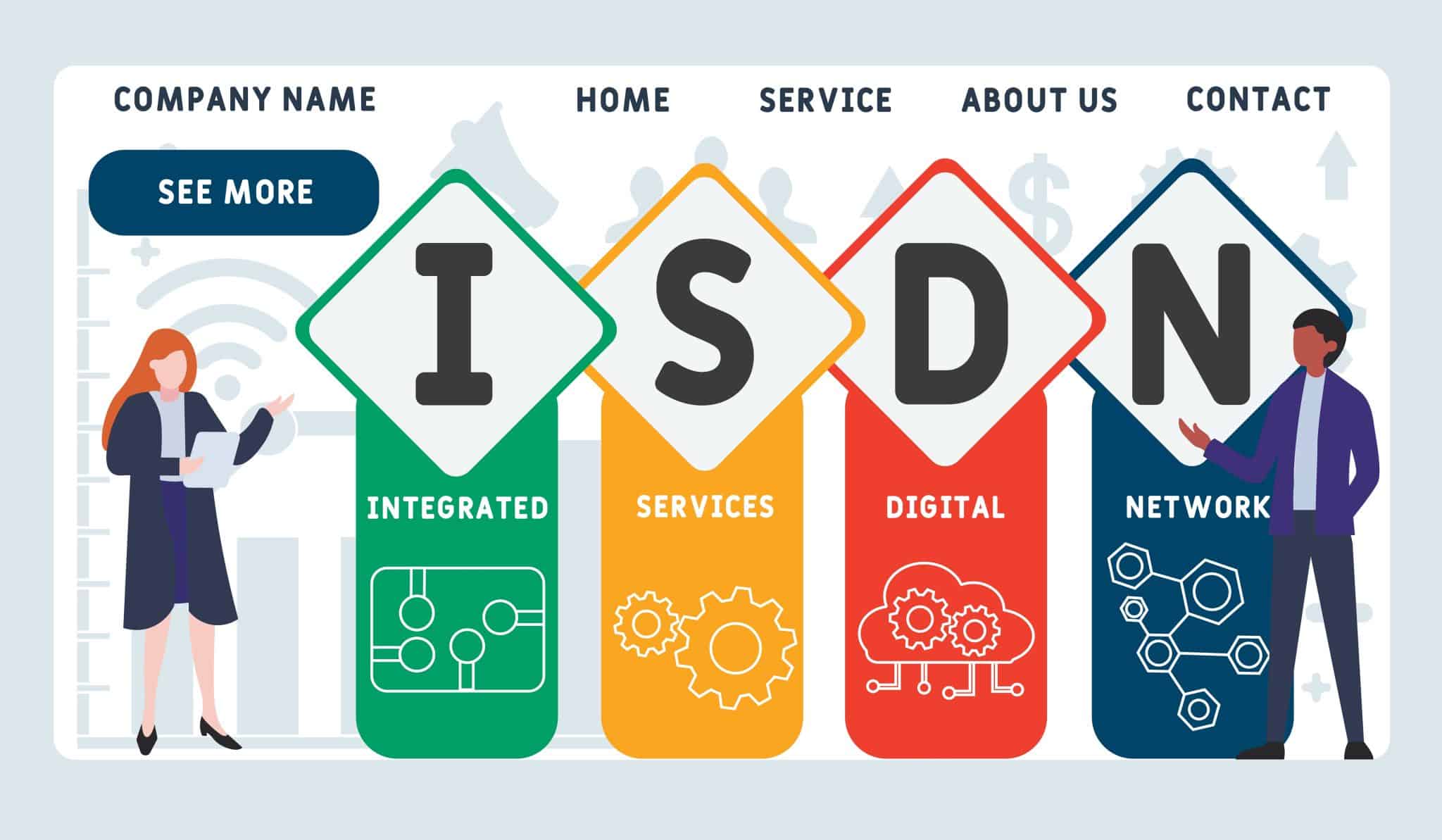What is ISDN? Advantages, Types, and Who Uses it
-
-
The Integrated Services Digital Network (ISDN) is a circuit-switched telephone network that combines voice and data transmission over a digital line. Consider it to be a set of standards for communicating data, voice, and signals.
ISDN is a revolutionary communication innovation that boosts network efficiency via digital technology. As such, it improves network quality alongside boosting its speed. Unlike traditional network connections, ISDN is reliable and can run faster than various modems.
In addition to the advantages of the ISDN, there are many other things to learn about it as well. This content will show you what it means, how it emerged, and more.
Keep reading.
ISDN Meaning and its Development
ISDN is the abbreviation for Integrated Services Digital Network. It’s a network system for circuit-switched telephones, responsible for voice and data transmission across digital lines.In other words, it’s a set of protocols that allows data, speech, video, and other network services to be sent over traditional phone lines.
It emerged during the 1980s as an alternative to analog phone systems to deliver more effective and dependable wireless communication.
In contrast to analog systems, ISDN offers superior quality and quicker transmission speeds thanks to its digital signaling utility for transmitting information.
Due to its ability to simultaneously carry data and voice across the same line, it’s a flexible technology with many uses.
The Development of ISDN
The necessity for a digital telecommunications service emerged in the 1970s, leading to ISDN’s development.
Many nations, notably the US, France, and Germany, started considering combining multiple telecommunications networks into one digital network.
As a result, ISDN emerged as a standardized mechanism to accomplish this.
During the early 1980s, the Basic Rate Interface (BRI), which was the first ISDN standard set, was created, offering two 64 kilobits per second (Kbps) bearer channels (B-channels) and a 16 Kbps D-channel (signaling channel).
The B-channels facilitated voice and data transmission, while the D-channel served for signaling information and call control.
Following the popularity of ISDN, more expansions were made to its capabilities, establishing more global standards with the assistance of the International Telecommunication Union (ITU).
As a result, the Primary Rate Interface (PRI) set emerged, providing higher capacity, unlike the BRI.
The PRI provided 23 B-channels and a single 64 Kbps D-channel in North America; in Europe, it offered 30 B-channels and a 64 Kbps D-channel.
As years passed, ISDN spread to various countries for professional and business applications. It offered several advantages like digital transmission, swift connection setup durations, and simultaneous voice, video, and data transmission across one line.
Types of ISDN
ISDN (Integrated Services Digital Network) comes in two types which are the Basic Rate Interface ISDN (BRI-ISDN) and Primary Rate Interface ISDN (PRI-ISDN).The BRI and PRI use B channels to send data, while the D channels serve other communication forms. However, the number of channels used to achieve these operations in both ISDN types differs.
BRI uses just two B-channels and a D-channel with a 128 Kbps maximum speed, while the number of channels the PRI uses depends on its location. Moreover, it’s adjustable for a rate of about 2.94 Mbps.
PRI can use up to 23 B-channels with a D-channel and double it for increased speed, providing a D line for emergency backup.
The BRI type of ISDN network works like a lower-tier service, providing basic needs at an affordable cost.
On the other hand, the PRI functions like the leading service, providing better connections, faster speeds, and increased reliability.
Despite the similar capabilities of BRI and PRI, they still have several differences, like reliability (in terms of speed).
ISDN provides a fixed speed rate for BRI and PRI. BRI can 128 Kbps across a standard copper wire, split into 64 Kbps in the B-channel and 16 Kbps across the D-channels.
However, PRI can multiply the speeds of BRI, making it faster, even though both use B channels for accessing the 128 Kbps.
ISDN-supported Services
ISDN supports several kinds of services, which include plain old telephone service, data transmission, fax, video conferencing, and even integrated services.
Here’s how ISDN supports these services:
- Plain Old Telephone Service (POTS): ISDN traditionally allows the transmission of voice calls like analog telephone infrastructures.
- Data Transmission: It offers faster digital data transfer than analog modems. It may accommodate some data protocols, including Frame Relay and X.25.
- Fax: ISDN supports the digital transmission of fax data, providing enhanced quality and reliability compared to analog fax machines.
- Video Conferencing: ISDN accepts real-time audio and video communication between several parties, making it a reliable solution for video conferencing uses.
- Integrated Services: On a single line, ISDN combines several services, including video, data, and voice.
Irrespective of the supported services and speed, many businesses and individuals are switching to more enhanced innovation, Voice Over Internet Protocol (VoIP), considering its sophisticated capabilities.
Notwithstanding, there are still people using ISDN, which could be their reason.
Why Choose ISDN – Advantages
ISDN is way more advanced than the traditional dial-up connection because it provides higher internet speeds.
It also serves as a middleman for individuals looking for internet connections without broadband internet.
While ISDN is phasing out gradually, a few developments emerged, including the Broadband ISDN (B-ISDN), built for transmitting data across fiber optic cable, and ISDN BRI, aimed at improving voice services.
Notwithstanding, ISDN offers numerous digital services which operate across the copper wire. It also supports digital signals broadcast across telephone lines.
ISDN can link devices like fax machines, credit card readers, and other devices while allowing them to function across a single line.
Compared to some modems, ISDN can provide higher rates for data transfer while running at high speed.
Some other advantages of ISDN include:
- Quality of service
- Swift connection establishment
- Quicker data transmission
- Digital communication
Despite its high cost of installation, ISDN is worth it. However, if you’re looking for a more cost-effective alternative with higher data transmission rates and reliability, a popular option is the Voice Over Internet Protocol (VoIP).
Why Consider VoIP as an Alternative to ISDN?
VoIP is the abbreviation for Voice Over Internet Protocol, a modern communication innovation that supports incoming and outgoing calls across the internet.
Many individuals and businesses are migrating to VoIP due to its feature-rich services and phone number solutions.
Notwithstanding, many reasons exist to consider VoIP as an alternative to ISDN. They include:
Cost Savings
VoIP has the potential for cost reductions, one of its key benefits. VoIP calls are usually more economical than regular landlines, particularly when making distant or international calls.
You can reduce the high expenses tied to traditional phone systems while taking advantage of your provider’s cheaper or even limitless call plans.
But that’s dependent on your preferred VoIP service provider and the features you picked.
Feature-infused Services
VoIP offers several features and capabilities that improve your ability to communicate. Some of these features include but are not limited to voicemail, call waiting, call forwarding, call recording, video conferencing, virtual attendants, etc.
Also, VoIP systems come with web interfaces that are straightforward to access, allowing users to manage and modify the phone’s services based on their needs.
Mobility and Flexibility
VoIP provides a lot of mobility and flexibility, allowing you to use your VoIP phone system for calls from anywhere. However, it would be best to have a solid internet connection.
This particular attribute of VoIP is helpful for those who travel a lot, remote employees, and companies with multiple branches.
With VoIP, accessing your calls, checking voicemail, and using IP phones on tablets, computers, and any device is now achievable.
Integration with Other Apps
VoIP is compatible with many business systems and applications, including call center platforms and Customer Relationship Management (CRM) tools.
As such, users can make the most of features like screen popping with client details, auto call logging, and click-to-dial to streamline their workflows and enhance productivity.
Innovative Collaboration Utilities
VoIP is evolving, integrating innovative collaboration features to boost teamwork and enhance organizational communication patterns.
As such, it provides users with instant messaging, file-sharing options, presence indicators (active or offline), and video conferencing.
These advanced collaboration utilities will achieve efficiency and seamless communication across various locations.
Scalability
VoIP is a revolutionary technology, prone to more advancements over time. Its high scalability makes it an ideal option for small and large businesses.
Unlike traditional phone systems, adding, removing, and replacing phone lines is now hassle-free.
Also, with many VoIP service providers offering flexible phone solutions, businesses can easily follow the evolving VoIP technology, adding new features to their services as their business grows. As such, the need for more infrastructure upgrades or extra hardware will reduce.
Future-proof Solution
VoIP and other digital communication innovations are gradually replacing outdated landline systems.
It is a future-proof alternative in line with the growing technological advancements, so it is a good idea now.
VoIP guarantees that you won’t lag like past communication infrastructures. Thus, it provides greater flexibility for enhancements in the future.
Notably, the quality of your VoIP call depends on how reliable and robust your internet connection is.
Therefore, it’s essential to have a reliable and high-speed internet connection to ensure optimal performance.
Tips for Choosing the Right VoIP Provider
Selecting a suitable VoIP provider is vital to guarantee reliable and excellent communication solutions for your personal needs or business.
The following tips will help you choose the best VoIP provider:
Know Your Needs
Identify your specific requirements and desires before going for VoIP. Call volume, number of users, system integration, international calling criteria, and preferred services like video conferencing or call recording are just a few things to consider.
Scalability
Consider your potential plans for development and pick a provider that can upgrade their services to suit your growing needs. Scalability and flexibility are vital for preventing challenges as your business advances.
Call Quality and Reliability.
Choose a VoIP service provider that delivers reliable services along with high-quality calls. To guarantee dependable connections and crystal-clear audio transmission, look at their network architecture, redundancy procedures, and technology.
Features
List the features you need, like voicemail, call forwarding, virtual extensions, an auto-attendant, or compatibility with mobile devices. Check to see if the VoIP service has these options available and if they meet your communication requirements.
Customer Service and Support
Choosing a VoIP provider with reliable support and a customer care team is essential if any technical issue arises. So, check the support team of your preferred VoIP provider and confirm their response speed. Advisably, check their testimonials and user reviews to measure their customer service level.
Reviews and Reputation
Check the VoIP provider’s reputation. To learn about other people’s experiences, search for reports, reviews, or recommendations online. Good reviews and an impressive reputation can signify the reliability of your preferred provider.
Pricing and Subscription Plans
Compare the pricing and plans from various providers. Consider things like setup fees, per-minute costs, and international calling charges. Examine the price structure to see whether it fits your spending budget and usage patterns.
Integration Capabilities
Check whether the VoIP service provides integration options for your existing communication systems.
Straightforward integration with various apps like CRM platforms, etc., can improve your entire communication performance.
Contracts and Trial Period
Choose a VoIP provider that lets you try its services for free before upgrading to premium plans.
Also, review your preferred provider’s contract conditions to ensure they match your expectations.
This will also help you know about cancellation charges and the contract duration.
Security and Privacy
Ensure the VoIP provider’s safety protocols can secure your data and calls from unapproved access or interception.
Based on your specific needs, look for your preferred provider’s encryption mechanisms and communication security, confirming if they adhere to industry standards like GDPR or HIPAA.
Conclusion
VoIP is revolutionizing communication techniques between businesses, customers, and employees. With versatility, cost-efficiency, flexibility, and scalability, VoIP could become the leading communication medium for small and large organizations.
Since ISDN is gradually phasing out as its capabilities are behind users’ needs, VoIP adoption is soaring dramatically.
If you’re considering a VoIP system, follow the tips above to choose the right provider. You can research your preferred provider, exploring their services and reputations.
FAQs
Why is VoIP preferred on ISDN?
VoIP works on an internet connection, allowing users to make and receive calls or even send text messages without network issues. However, the ISDN is prone to lag due to its network connection structure (B-channels and D-channels). Considering the network efficiency of VoIP systems, many individuals and businesses are migrating to this technology.
Are there different types of ISDNs?
There are 3 types of ISDNs which are Basic Rate Interface (BRI-ISDN), Primary Rate Interface (PRI-ISDN), and Broadband (B-ISDN). BRI is cheaper and offers lower-tier service, while PRI is more reliable, faster, and provides better connections at a higher cost. Meanwhile, the B-ISDN is the most advanced, with higher performance than the others.
What’s the main difference between ISDN and VoIP?
ISDN is a circuit-managed telephony network built to deliver data and speech through a digital connection. Meanwhile, VoIP is a virtual phone number solution for making voice and video calls, receiving and sending SMS, etc., across an internet connection.
What are the functions of the 3 ISDN channels?
ISDN has 3 channels: B-channel, D-channel, and H-channel. The B-channel is responsible for a speed of about 64 Kbps, usable for home utility. The D-channels are responsible for speed within 16-60 Kbps, used for the B-channel signaling, while the H-channel provides speeds ranging from 384 Kbps to 1920 Kbps.
Jeff Beckman Tech Writer
Jeff Beckman Tech Writer
View all posts by Jeff BeckmanJeff Beckman is a content writer and copywriter with 5+ years of experience in technology. He provides enjoyable, educational content through his experience working for various publications.
More VoIP Services GuidesView all
Latest News View all
Biden’s Manipulated Video Will Continue To Stay On Facebook; Oversight Board Confirms
A manipulated video of Joe Biden that was recently circulated on Facebook will not be taken down because it doesn’t violate Meta’s content policy, no matter how incoherent those policies...
Bitcoin Consolidates Around $43,000 as ETF Buzz Quiets Down – Will It Reach $100,000 After Halving?
The flagship cryptocurrency, Bitcoin, has been grappling with bearish pressure following the ETF-engineered rally in early January. However, despite the depressing short-term outlook, many believe BTC could hit $100,000 after...
REGULATION & HIGH RISK INVESTMENT WARNING: Trading Forex, CFDs and Cryptocurrencies is highly speculative, carries a level of risk and may not be suitable for all investors. You may lose some or all of your invested capital, therefore you should not speculate with capital that you cannot afford to lose. The content on this site should not be considered investment advice. Investing is speculative. When investing your capital is at risk. Please note that we do receive advertising fees for directing users to open an account with the brokers/advertisers and/or for driving traffic to the advertiser website.
Crypto promotions on this site do not comply with the UK Financial Promotions Regime and is not intended for UK consumers.
© Copyright 2024 Techreport. All Rights Reserved.
Scroll Up












